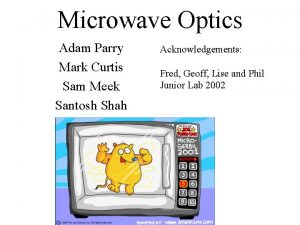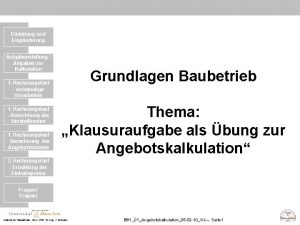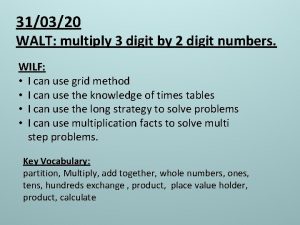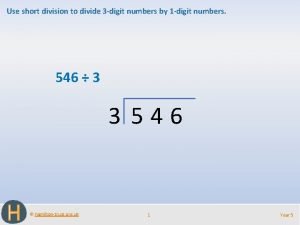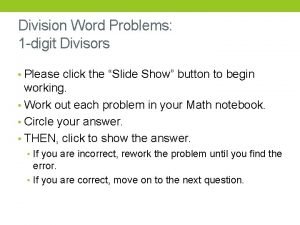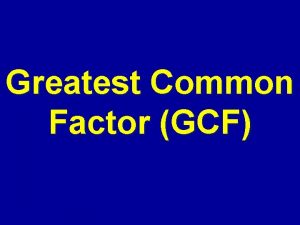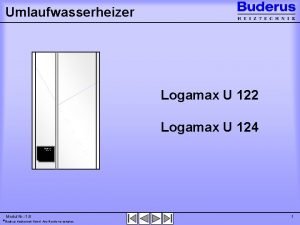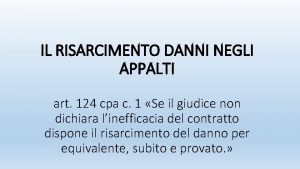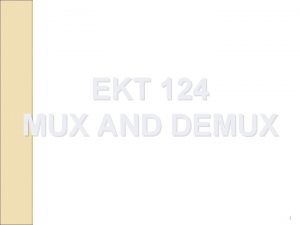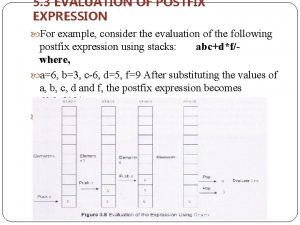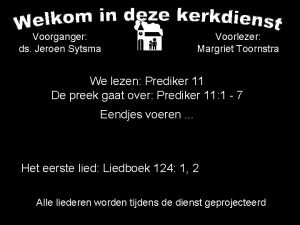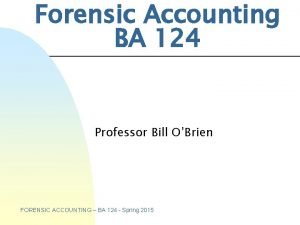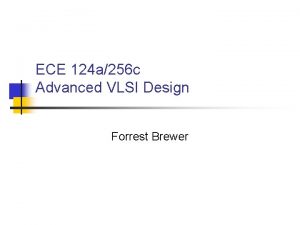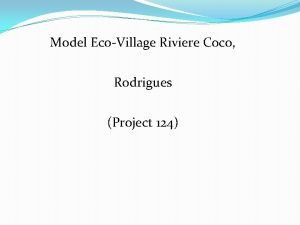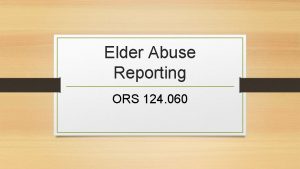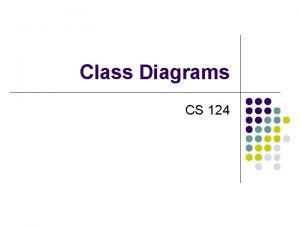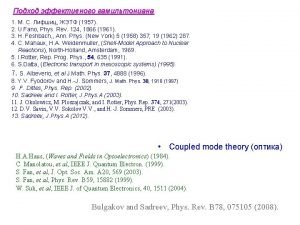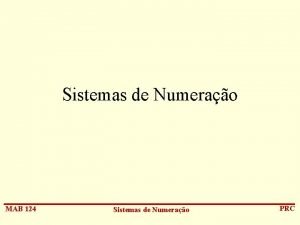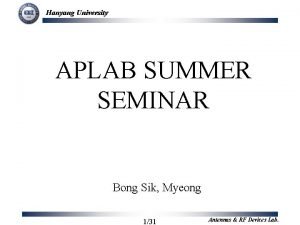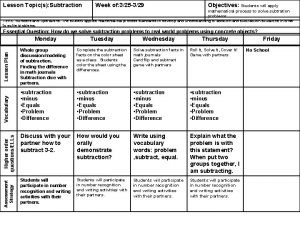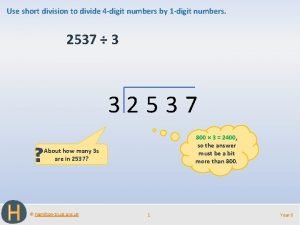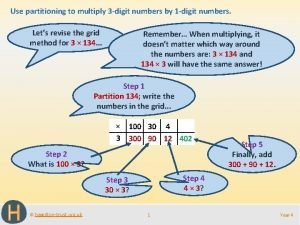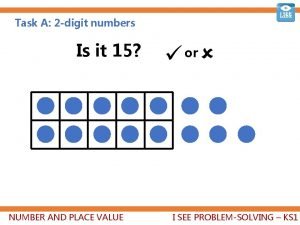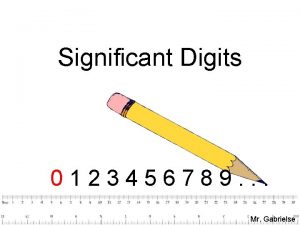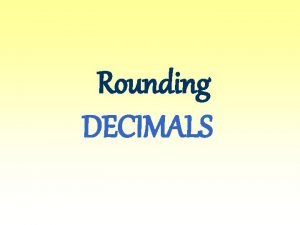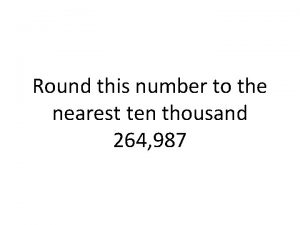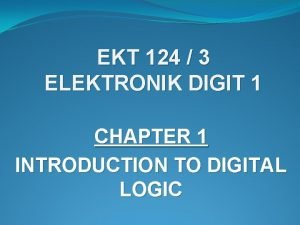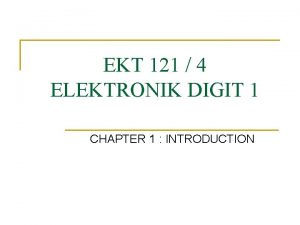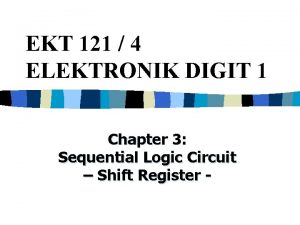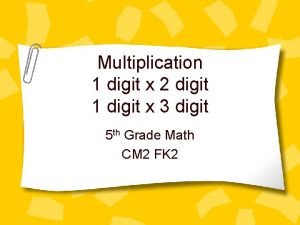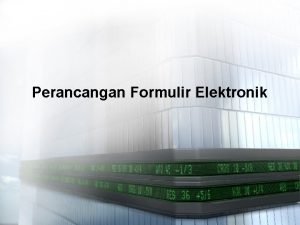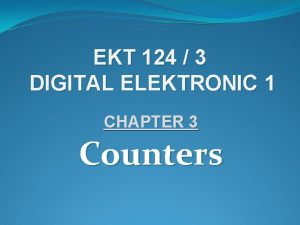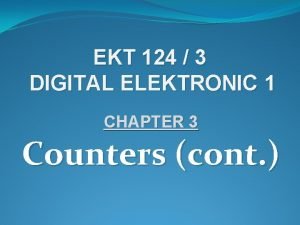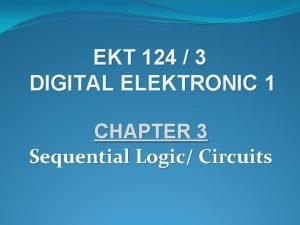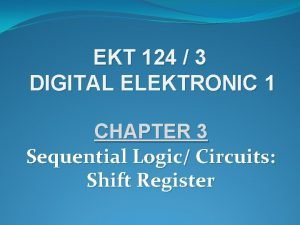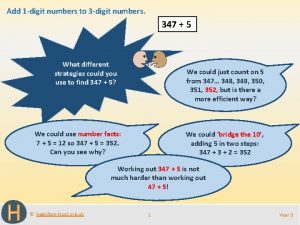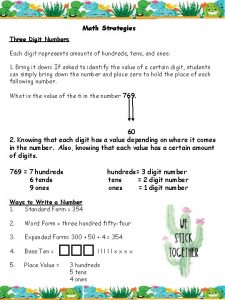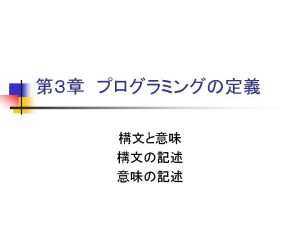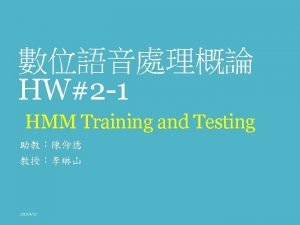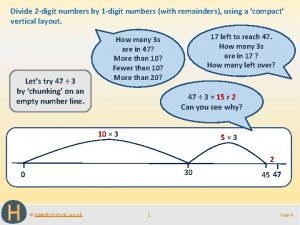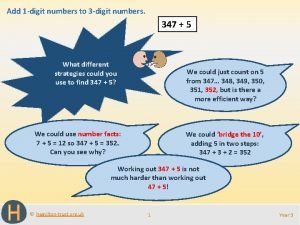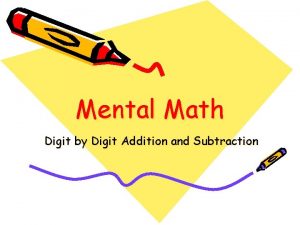EKT 124 3 ELEKTRONIK DIGIT 1 CHAPTER 1



































- Slides: 35

EKT 124 / 3 ELEKTRONIK DIGIT 1 CHAPTER 1 INTRODUCTION TO DIGITAL LOGIC

BOOLEAN ALGEBRA q q q q Boolean Operations & expression Laws & rules of Boolean algebra Basic logic gates De. Morgan’s Theorems Boolean analysis of logic circuits Simplification using Boolean Algebra Standard forms of Boolean Expressions & truth tables

Boolean Operations & expression q Expression: v Variable: a symbol used to represent logical quantities (1 or 0) § Eg. : A, B, . . used as variable v Complement: inverse of variable and indicated by bar over variable § Eg. : Ā q Operation: v Boolean Addition – equivalent to the OR operation § Eg. : X=A+B A B X v Boolean Multiplication – equivalent to the AND operation § Eg. : X = A∙B A B X

Laws & Rules of Boolean algebra

Commutative Law of Addition Commutative law of addition, A+B = B+A the order of ORing does not matter.

Commutative Law of Multiplication Commutative law of Multiplication AB = BA the order of ANDing does not matter.

Associative Law of Addition Associative law of addition A + (B + C) = (A + B) + C The grouping of ORed variables does not matter

Associative Law of Multiplication Associative law of multiplication A(BC) = (AB)C The grouping of ANDed variables does not matter

Distributive Law A(B + C) = AB + AC (A+B)(C+D) = AC + AD + BC + BD

Boolean Rules (1) 1) A + 0 = A q Mathematically if you add O you have changed nothing q In Boolean Algebra ORing with 0 changes nothing

Boolean Rules (2) 2) A + 1 = 1 q ORing with 1 must give a 1 since if any input is 1 an OR gate will give a 1

Boolean Rules (3) 3) A • 0 = 0 q In math if 0 is multiplied with anything you get 0. If you AND anything with 0 you get 0

Boolean Rules (4) 4) A • 1 = A q ANDing anything with 1 will yield the anything

Boolean Rules (5) 5) A + A = A q ORing with itself will give the same result

Boolean Rules(6) 6) A + A = 1 q Either A or A must be 1 so A + A =1

Boolean Rules(7) 7) A • A = A q ANDing with itself will give the same result

Boolean Rules(8) 8) A • A = 0 q In digital Logic 1 =0 and 0 =1, so AA=0 since one of the inputs must be 0.

Boolean Rules(9) 9) A = A q If you NOT something twice you are back to the beginning

Boolean Rules(10) A + AB = A Proof: Proof A + AB = A(1 + B) = A∙ 1 =A DISTRIBUTIVE LAW RULE 2: (1+B)=1 RULE 4: A∙ 1 = A

Boolean Rules(11) A + AB = A + B q If A is 1 the output is 1 , If A is 0 the output is B Proof : A + AB = (A + AB) + AB RULE 10 = (AA +AB) + AB RULE 7 = AA + AB + AA +AB RULE 8 = (A + A)(A + B) FACTORING = 1∙(A + B) RULE 6 =A+B RULE 4

Boolean Rules(12) (A + B)(A + C) = A + BC Proof : (A + B)(A +C) = AA + AC +AB +BC DISTRIBUTIVE LAW = A + AC + AB + BC RULE 7 = A(1 + C) +AB + BC FACTORING = A. 1 + AB + BC RULE 2 = A(1 + B) + BC FACTORING = A. 1 + BC RULE 2 = A + BC RULE 4

LOGIC GATES q NOT Gate (Inverter) q AND Gate q OR Gate q NAND Gate q NOR Gate q X-OR and X-NOR Gates q Fixed-function logic: IC Gates

Introduction(1) q All Logic circuit and functions are made from basic logic gates q. Three basic logic gates: AND gate – expressed by “. ” v OR gate – expressed by “+” sign (note: note it is NOT an ordinary addition) v NOT gate – expressed by “ ’ “ or “¯” v

Introduction(2) q Think about these logic gates as bricks in a structure. q Individuals bricks can be arranged to form various type of buildings, and bricks can be used to build fireplaces, steps, walls, walkways and floor. q Likewise, individual logic gates are arranged and interconnected to form various function in a digital system q. There are several type of logic gates, just as there may be several shapes/sizes of bricks in a structure. By: Thomas L. Floyd & David M. Buchla

NOT Gate (Inverter) a) Gate Symbol & Boolean Equation b) Truth Table c) Timing Diagram

OR Gate a) Gate Symbol & Boolean Equation b) Truth Table c) Timing Diagram

AND Gate a) Gate Symbol & Boolean Equation b) Truth Table c) Timing Diagram

NAND Gate a) Gate Symbol, Boolean Equation & Truth Table b) Timing Diagram

NOR Gate a) Gate Symbol, Boolean Equation & Truth Table b) Timing Diagram

Exclusive-OR (XOR)Gate a) Gate Symbol, Boolean Equation & Truth Table b) Timing Diagram

Exclusive-NOR (XNOR)Gate XNOR 1 0 0 1 a) Gate Symbol, Boolean Equation

DIP and SOIC packages

Examples : Logic Gates IC NOT gate AND gate Note : x is referring to family/technology (eg : AS/ALS/HCT/AC etc. )

Performance Characteristics and Parameters q Propagation delay Time § High-speed logic has a short pdt. q DC Supply Voltage (VCC) q Power Dissipation § Lower power diss. means less current from dc supply q Input and Output (I/O) Logic Levels q Speed-Power product q Fan-Out and Loading

Thank you!
 Microwave optics
Microwave optics Ekt kalkulation
Ekt kalkulation How to multiply 2 digit numbers by 3 digit numbers
How to multiply 2 digit numbers by 3 digit numbers How to divide 3 digit numbers by 1 digit numbers
How to divide 3 digit numbers by 1 digit numbers Add 3-digit number to 2-digit games
Add 3-digit number to 2-digit games Multi digit division word problems
Multi digit division word problems Chapter 3 compute with multi digit numbers
Chapter 3 compute with multi digit numbers Old ucas points calculator 2015
Old ucas points calculator 2015 Gcf
Gcf Todos juntos o louvemos
Todos juntos o louvemos Buderus u 124
Buderus u 124 Salmo 29 estudo
Salmo 29 estudo Art. 124 cpa
Art. 124 cpa In 124
In 124 Evaluate the postfix expression: 562 +124/
Evaluate the postfix expression: 562 +124/ Liedboek 124
Liedboek 124 Fpb dari 56 92 dan 46
Fpb dari 56 92 dan 46 Ba 124
Ba 124 Ece 124
Ece 124 Bill 124
Bill 124 Project 124
Project 124 Ors 124
Ors 124 Cs 124
Cs 124 Rev 124
Rev 124 124 binario
124 binario For inquiries please call or text
For inquiries please call or text Hasta baj
Hasta baj Iec tc 124
Iec tc 124 Subtract 329 from -124
Subtract 329 from -124 Four digit division
Four digit division How to multiply three digit numbers
How to multiply three digit numbers Scientific figures
Scientific figures 10 digit number money
10 digit number money Digit
Digit 4 or less let it rest 5 or more raise the score
4 or less let it rest 5 or more raise the score What is 849 rounded to the nearest hundred
What is 849 rounded to the nearest hundred
